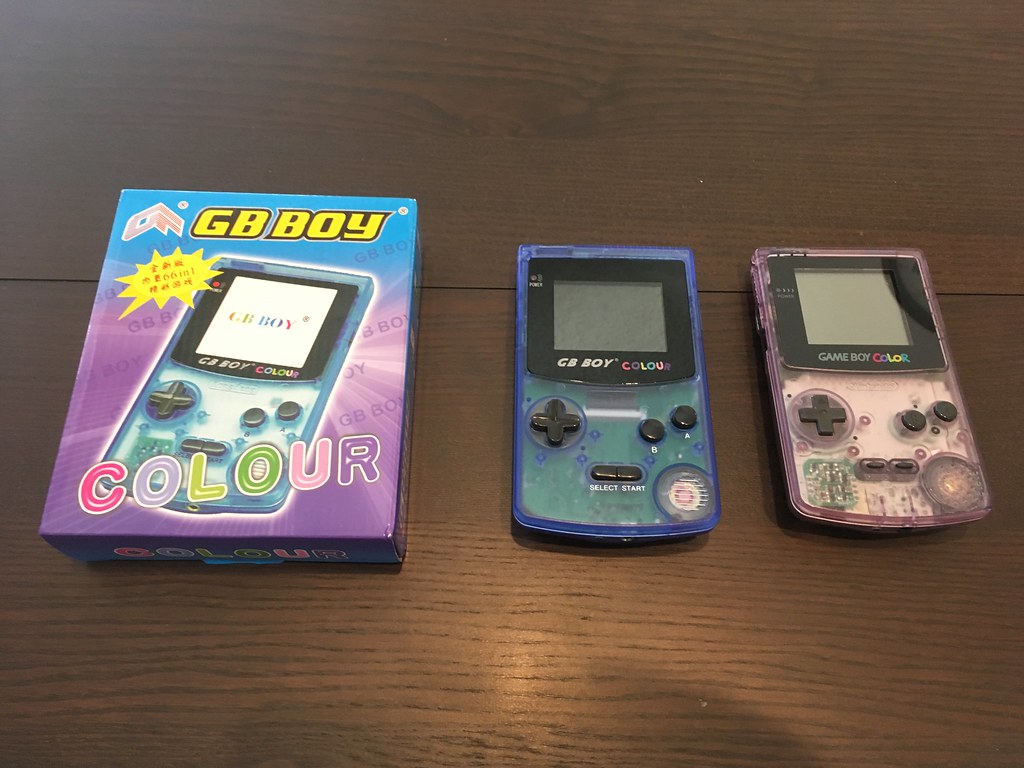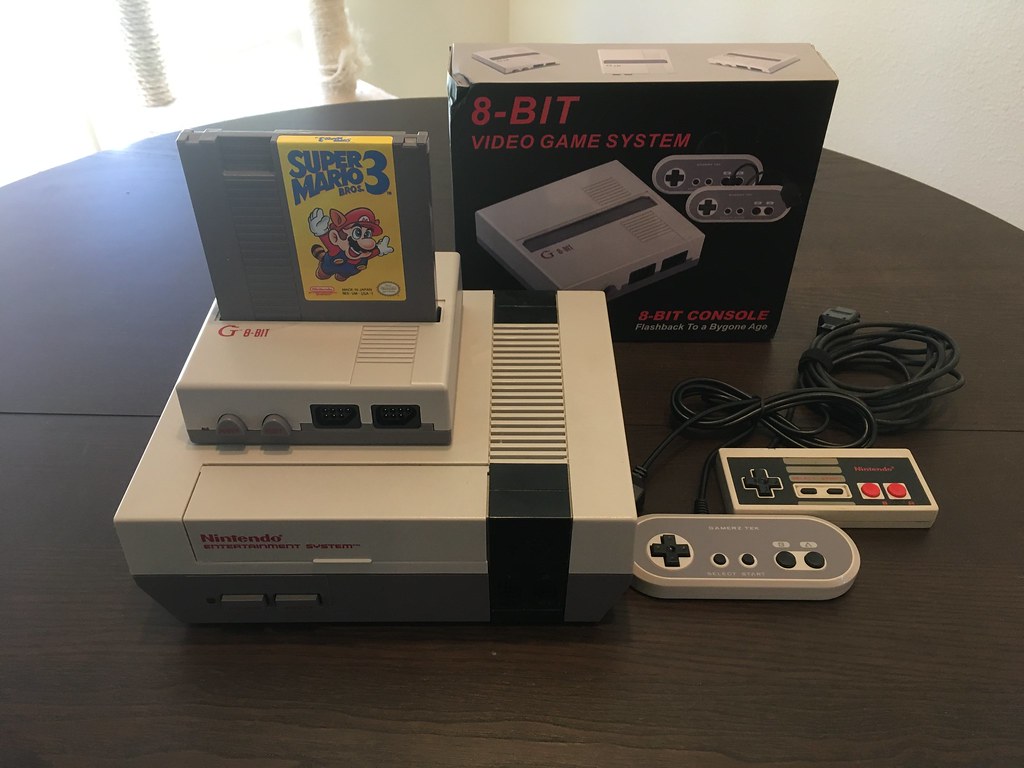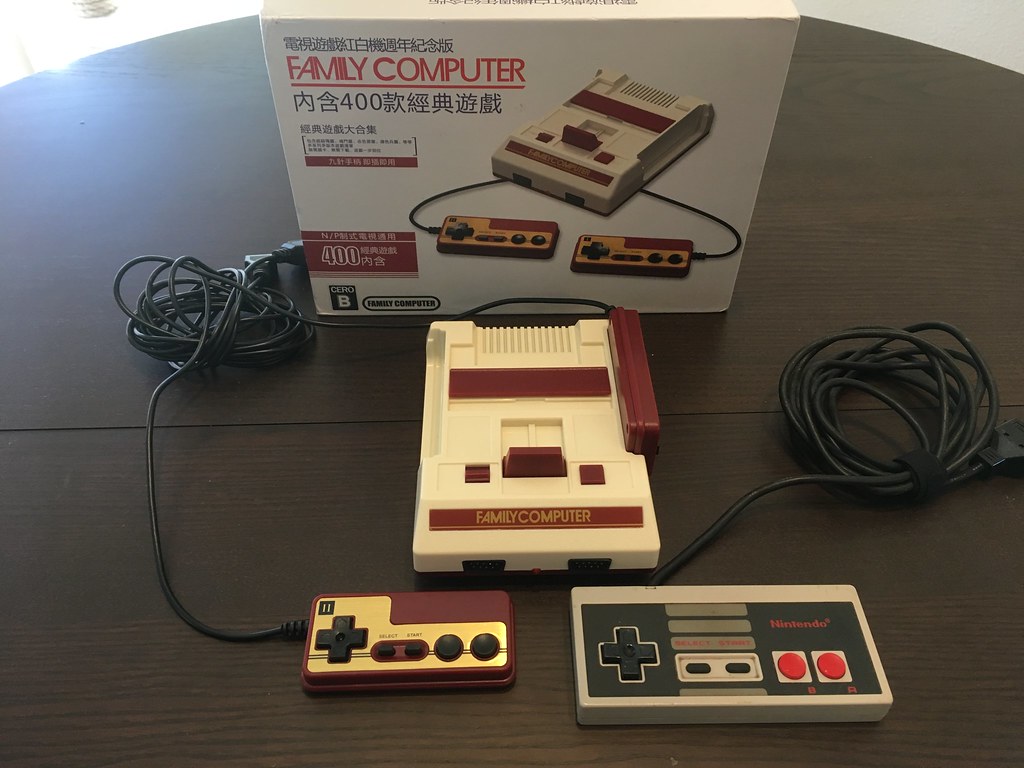Re-Buying My Childhood, Part 2: Send in the Clones
In my last post, I detailed the last six months of re-buying my old Nintendo systems and cartridges, beginning with a Game Boy Color back in October, after watching a few videos online during the NES Classic Edition hype.
 Actually, a few details were left out.
In truth, the Game Boy Color was the second console I bought in October, but the first I received.
This was the video I watched which got me interested, a review of a clone system called the GB Boy Colour by Kong Feng.
It’s a near replica of the Game Boy Color, but has a few notable enhancements.
Actually, a few details were left out.
In truth, the Game Boy Color was the second console I bought in October, but the first I received.
This was the video I watched which got me interested, a review of a clone system called the GB Boy Colour by Kong Feng.
It’s a near replica of the Game Boy Color, but has a few notable enhancements.
I ordered it from AliExpress for about $30, and started the multi-week wait for it to arrive from China. … Then I got antsy and bought a real GBC locally the next week.
At first glance, the GB Boy Colour looks nearly identical to a real GBC. Placed next to one, you can see it’s slightly wider and taller, but without the comparison it’s almost impossible to tell. What is noticeable (but not terribly annoying) is the screen size. The diagonal size is the same as a real GBC (2.3 inches), but its aspect ratio is different, with graphics slightly wider and squatter.
But its other screen feature makes up for it: the screen is backlit. The Nintendo Game Boy, Game Boy Color and Game Boy Advance all had no backlighting, with the Game Boy Advance SP being the first to introduce a built-in light (albeit a frontlit screen). I owned an original Game Boy as a kid, and don’t particularly remember the lack of lighting being a problem. However, I briefly owned a GBA in the 2000s, and it was nearly unplayable. I had an external light attachment permanently installed, and even then, it would only work if you held the GBA at a certain angle. The backlight on the GB Boy Colour is nice and bright, and evenly illuminates the screen.
The GB Boy Colour’s D-pad and buttons are the same size as the GBC’s, and feel good. The D-pad’s shape is a little more rounded than the GBC’s square cross shape, but is enjoyable (perhaps even more so than the GBC’s). My only complaint is you can “bottom out” the D-pad, where it’s possible to press the middle of the cross and register all four directions at once. For me, this only tends to happen in frantic games which require a lot of movement changes, such as Operation C.
All of the GBC’s features are replicated on the GB Boy Colour, with one exception: the infrared port is missing, with a black window on the top going nowhere. But as very few games used the infrared port, I don’t miss it.
As far as I can tell, the console has full compatibility with GBC and GB games; all of the cartridges I own play perfectly. But when you turn on the GB Boy Colour without a cartridge inserted, it boots into a built-in pirate multi-cart. The title says “188 in 1”, but many of the games are repeats. The cart only contains 66 unique games, but this is reflected on the AliExpress page and the box. It’s got a good mix of popular (again, pirated) North American games, Japanese-only games and homebrew games. One thing to note is that, while the GB Boy Colour is a full Game Boy Color clone, all of the built-in games are original Game Boy Games (though a few games have GBC-specific enhancements, like Donkey Kong). All play perfectly, except for a few which expect a battery save feature (again, Donkey Kong) which is not present on the built-in ROM.
This console wasn’t bought as a novelty; I use it all the time instead of the GBC to play Game Boy games, as its extra features (namely the backlight) make it much better to play than the original.
 You would think I would learn from history, but no.
A few months later, I came across the Super Players Entertainment System SNES clone on AliExpress.
I ordered it, got antsy while waiting for it to be delivered, and bought a real SNES in the meantime.
You would think I would learn from history, but no.
A few months later, I came across the Super Players Entertainment System SNES clone on AliExpress.
I ordered it, got antsy while waiting for it to be delivered, and bought a real SNES in the meantime.
Unlike the GB Boy Colour, there isn’t a huge reason to own this versus an authentic SNES. The console is modeled after the SNS-101 (“SNES Mini”), but is lighter then an authentic SNS-101, and much lighter than an original SNES. The plastic is not terribly thin, but again, thinner than an authentic model. Overall, its quality is acceptable, nothing to complain about, but not up to original standards. Game compatibility is 100%, as far as I can tell, and gameplay is identical to the original.
It lacks an RF out connector, but makes up for it with an S-Video connector in addition to A/V RCA. So if your TV has S-Video, this would make for a better video signal. The included controllers are decent, though the buttons are a bit stiffer than an authentic controller.
The biggest annoyance is the power connector, in that its barrel size is not the same as an authentic SNES. And, hilariously, the wall wart is branded Creative, and has a Europlug connector, despite this being an NTSC unit. I can see this playing out at the factory: “We need a power cable for this unit.” Reaches into box, pulls out random cable. “Yeah, this will work.” At least the wall wart supports 120v and the Europlug detaches to a figure-eight connector, so I can use it with a North American cable.
 I bought my NES on eBay, and didn’t expect to also buy a clone.
The problem is the NES doesn’t exactly age well.
When the console arrived, I could only get a few games to play reliably on it.
Cleaning the cartridge connectors helped a bit, I tried repairing the console’s 72-pin cartridge assembly , and even went as far as replacing the 72-pin assembly.
But even after all that, reliability is more miss than hit.
Top-loader NES units are supposed to be more reliable, but the NES-101 can be fairly expensive on eBay, so I turned to purchasing a clone.
I bought my NES on eBay, and didn’t expect to also buy a clone.
The problem is the NES doesn’t exactly age well.
When the console arrived, I could only get a few games to play reliably on it.
Cleaning the cartridge connectors helped a bit, I tried repairing the console’s 72-pin cartridge assembly , and even went as far as replacing the 72-pin assembly.
But even after all that, reliability is more miss than hit.
Top-loader NES units are supposed to be more reliable, but the NES-101 can be fairly expensive on eBay, so I turned to purchasing a clone.
The GamerzTek NES 8-Bit Entertainment System is hilariously tiny. But for $15, it’s hard to go wrong. It’s incredibly lightweight (the internals are literally an edge connector, an NES-on-a-Chip (NOAC) and a few PCBs to mount the ports and buttons), and it contains no extra features. Video output is mono A/V (no RF output). But it works well, with one moderate exception I’ll get to later. Every game I’ve thrown at it starts immediately, unlike the original NES in its current state, except for Super Mario Bros. 2 (and I think that may be a PCB problem with that specific cartridge). I’ve read that it has compatibility problems with a small handful of cartridges (which all NOACs seem to have problems with), but I don’t own any of the affected cartridges).
The bundled controllers are excellent, literally better than the originals in my opinion. Buttons are responsive and feel good, and the controller design is rounded (though not dog-bone like the NES-101’s redesigned controllers), and slightly wider than the original. Seriously, I love them. Of course, the GamerzTek console accepts all regular NES controllers, and likewise the GamerzTek controllers work on an authentic NES.
The biggest problem with the GamerzTek console is its sound. The audio has a constant buzzing, which is worst during black screens with no sound being played, and not as bad during gameplay and other audio playing. And the sound effects are off. The former is definitely noticeable, though you probably wouldn’t pick up the latter unless you already knew the game.
A minor annoyance, like the Super Players Entertainment System, is the power connector. As opposed to the SPES having a different barrel connector than the SNES, the GamerzTek does have the same barrel connector as the NES… but it expects 6 volts instead of the NES’s 9 volts. So not only can I not use an NES power brick on the GamerzTek, but I had to label the GamerzTek console and brick to make sure I don’t mix them with the NES.
This is my go-to console for playing NES games, not because it’s great (the audio issues are annoying), but because it works reliably. Coincidentally, between ordering this and it arriving, The 8-Bit Guy released a video on clone NES consoles which also featured the GamerzTek NES clone.
(I’ve got another NES clone on the way, a ZOGA NES-101 clone, though it’s being shipped from China so it’ll be a few weeks before I receive it.)
 The Cool Baby RS-36 is not a clone of the original Famicom; instead it’s meant to be a clone of the Famicom Mini, the Japanese equivalent of the now-discontinued NES Classic Edition.
It’s smaller than an original Famicom, and a near perfect physical clone of the Famicom Mini.
The Cool Baby RS-36 is not a clone of the original Famicom; instead it’s meant to be a clone of the Famicom Mini, the Japanese equivalent of the now-discontinued NES Classic Edition.
It’s smaller than an original Famicom, and a near perfect physical clone of the Famicom Mini.
I’ll admit, it’s damn cute. But beside that, it’s pure garbage. The controllers are tiny – at first I thought that was a design choice on the clone manufacturer’s part, but turns out the Famicom Mini also had smaller controllers than the Famicom, while North America got full size NES controllers with the NES Classic Edition. Sorry Japan, you got the short stick here. But these clone controllers are terrible. Fragile thin plastic, and button presses don’t register half the time.
This system does not accept cartridges. Instead, it has a built-in pirate cart advertised on the site as “400 in 1”, but the main menu says “500 in 1”. Of course, most are repeats; the actual count is closer to 200 titles, and most are cheap homebrew or shovelware titles. Very few well known (North American) titles, no Mario titles except for the original Mario Bros. (not Super Mario Bros.). On the other hand, if you like Contra, this is for you. Each title (Contra 1, 2, 3, 6, 8… wait a second…) boots into a sub-menu which has a bunch of cheat modifiers. Want to start on the 5th level with permanent Spread gun and 30 lives? This system has you covered.
I now have more clone consoles than authentic retro consoles. By why stop at hardware? Tomorrow, part three: The Clone Wars.